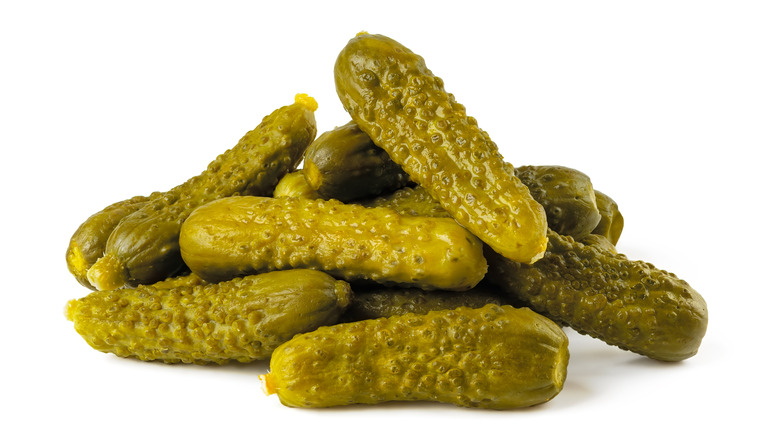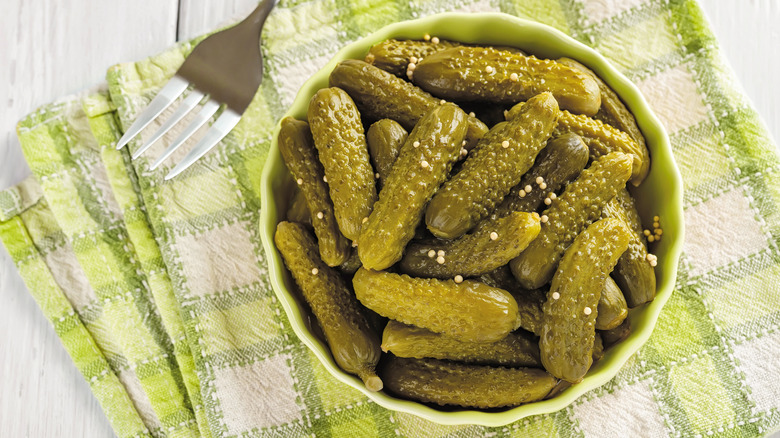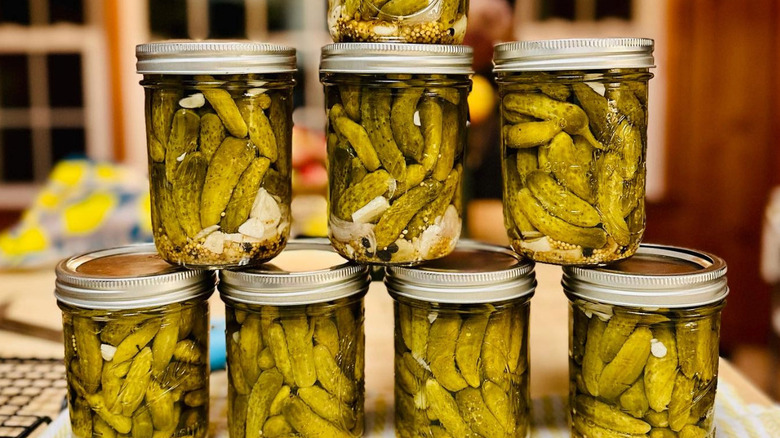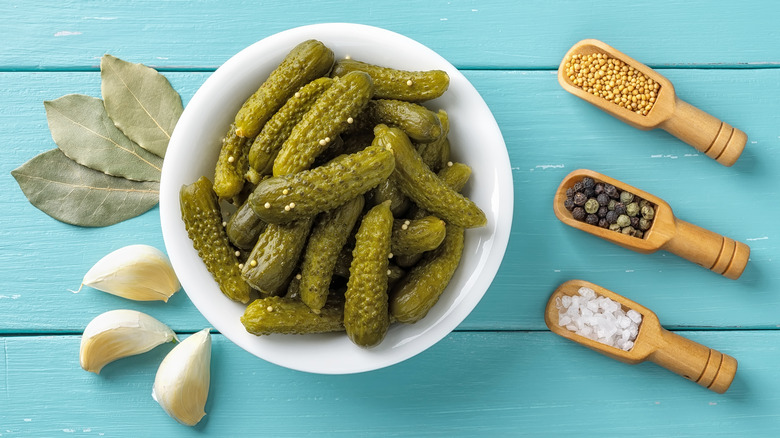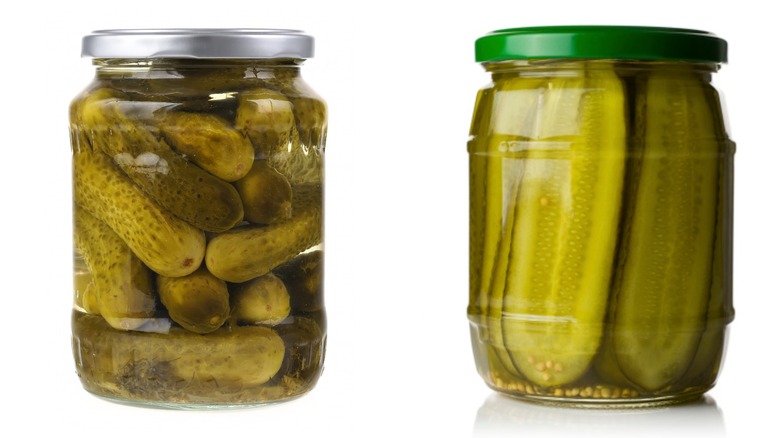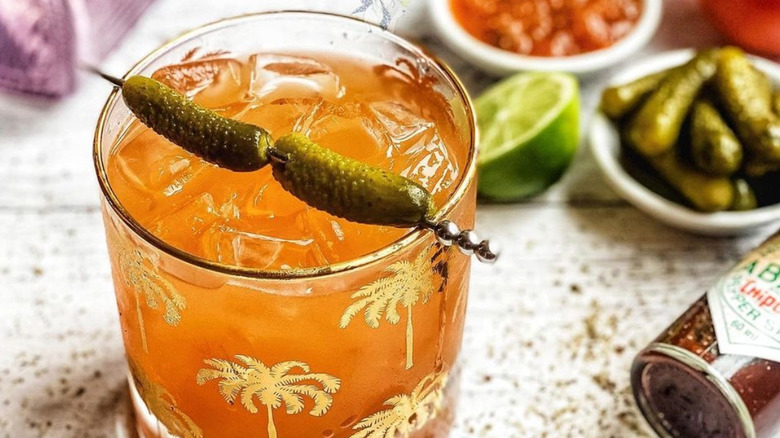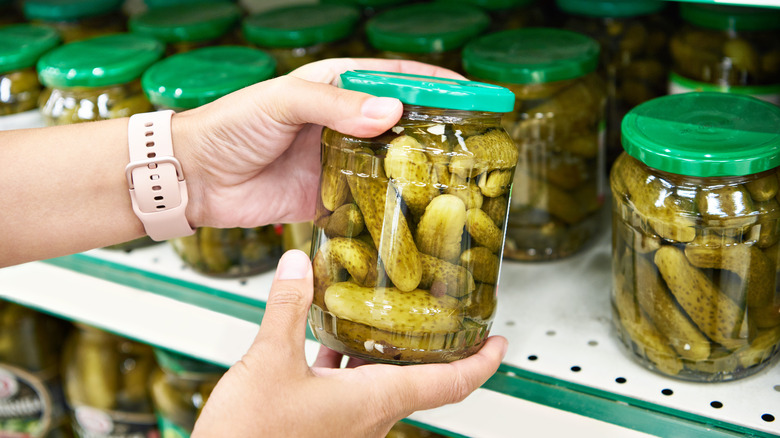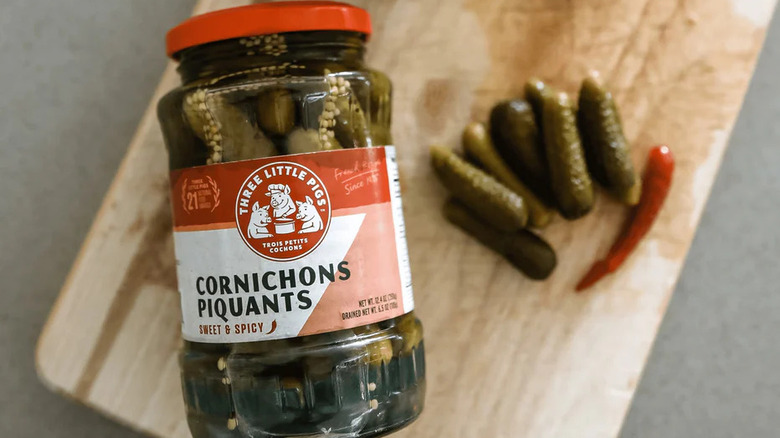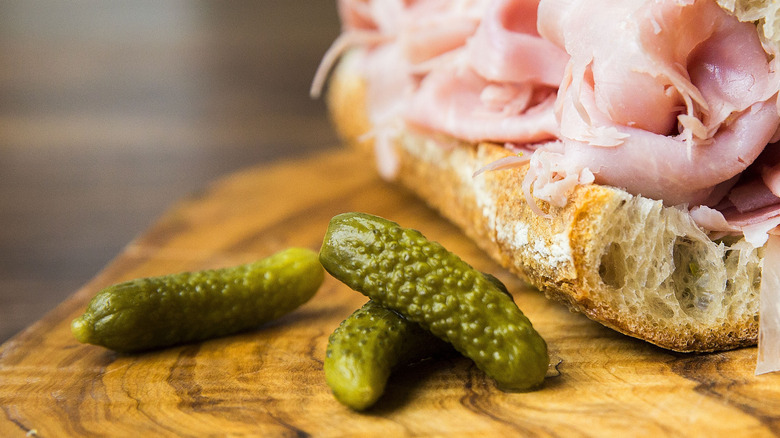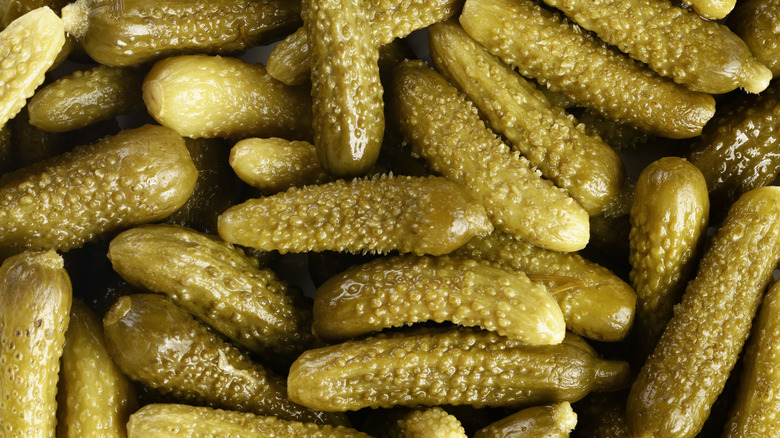Cornichons Are More Than Just Tiny Pickles
It's not uncommon to find a charcuterie board, bloody mary, or deli sandwich served with one or many little pickles. Take a closer look at those pickles: if they're no bigger than your pinky finger and have a tart, sour flavor with lots of crunch, it's probably a cornichon, a very special French pickle.
Cornichons are gherkins, tiny pickles that have a snappy texture and a bright green color. Packed in small jars and cans, they may get overshadowed on the store shelves by larger jars of whole pickles, pickle slices, and pickle spears, but don't be fooled by their diminutive size; those cornichons can more than hold their own, and they're much more versatile than large pickles, too.
Here's all there is to know about little cornichons, including how they taste, the best ways to use them, and where you can find some to take home today.
What are cornichons?
Cornichons, pronounced "kohr-nee-SHONES," are tiny, bumpy, bright green, whole, pickled cucumbers. Interestingly, the term cornichon is the name for both the pickled and the fresh variety of these little fruits. (Yes, like tomatoes, cucumbers are actually fruits!) Cornichons are a type of gherkin, a small-sized member of the cucurbitaceae family of plants which includes larger cucumbers as well as gourds and squashes.
These gherkins are picked when they're still immature on the vine, which is why they're so little and crunchy. The average size for picked cornichons is between one and three inches, and the little green guys are often covered with tiny spines or bumps. They typically have few to no seeds, again as the result of the fruits being picked when they're so young.
Fresh cornichons are sold in produce markets in France and other countries in Europe. In the United States, however, fresh, raw cornichons are harder and are usually only available from small, specialty growers. However, the pickled variety is easy to find in stores: packed in pickling liquid that contains salt, vinegar, and spices, sold in either jars or cans.
How cornichons are made
As with any pickle, the process of making cornichons involves submerging the fresh gherkins in a hot, vinegary brine to infuse them with flavor. Before this happens, fresh cornichons are heavily salted and left to rest for 24 hours. They're then canned at home or packed into jars at a commercial facility. As they pickle, the brine preserves cornichons and gives them a long shelf life. One of the things that makes cornichons unique is that the gherkins used are very tiny: between less than an inch and three inches long. The tiny size allows producers to pickle cornichons whole, unlike dill or bread and butter pickles that are often sliced. Larger cucumbers can be pickled whole too, of course, but they won't have the same crispy texture as little cornichons.
White vinegar is the vinegar of choice in the pickling liquid; it's more acidic than apple cider or other kinds of vinegar and less sweet as well. Plenty of kosher or pickling salt is also part of the brine, and traditional flavorings for cornichons are peppercorns, sliced or pearl onions, and garlic. Other possible flavorings to be found in cornichons depending on the brand or home cook are tarragon, cloves, dill, mustard seeds, coriander seeds, and bay leaves. To let the pickles fully cure and achieve the best possible flavor, they must rest for at least three weeks after canning. That's a long time to wait before opening the jar, but it's well worth it for that first bite of a perfect cornichon.
What do cornichons taste like?
All pickles have some degree of saltiness and a big punch of vinegar and spice flavor, whether they're dill slices for hamburgers or sweet bread and butter pickles. Cornichons are unique because while they're very salty they also have a flavor that's quite tart, even sour. That paired with a snappy crunch — which with larger, jarred pickles is often only found in those packed and sold cold — makes them really stand out from the rest of the pickle crowd.
Salt and sour are the most prominent flavors in cornichons, but there are also notes from the seasonings in the pickling liquid, including garlic, pepper, mustard seed, and bay.
Because cornichons pack so much flavor into a little bite, they're a favorite to set out as a fuss-free appetizer alongside other no-cook favorites like cured meats and crackers. Cornichons are also delicious when chopped and added to other dishes like cold chicken and tuna salads or in sauces for pork dishes. They have enough crunchy texture and sharp acidity to stand out even in these heavy recipes.
Are cornichons the same as pickles?
According to "The Food Lover's Companion" by Sharon Tyler Herbst and Ron Herbst, a pickle is defined as a "food that has been preserved in a seasoned brine or vinegar mixture." This means that the word pickle can apply to almost anything: cucumbers, of course, but also other fruits, vegetables, meats, eggs, and fish. Even if the field is narrowed down to just cucumbers, there is still a plethora of types: sweet, sour, spicy, dill, large, small, sliced, and whole.
The difference between cornichons and pickles is that while pickles can be any number of preserved foods, cornichons are just one specific type. They're always made from very tiny gherkins that are harvested before they fully mature. Cornichons are also always preserved whole — they're so tiny that there's no need to slice them! Finally, cornichons are known for their distinctive flavor that's salty but also very sharp and tart, as well as for their crispy texture. In short, cornichons are pickles but not all pickles are cornichons.
How to use cornichons
Cornichons can be enjoyed as a snack, as a garnish, or as an ingredient. Their tiny size and French moniker give them a fancy, upscale feel; these details plus the delightful flavor make cornichons perfect to put on display as an appetizer. Add the little pickles to cheese boards and charcuterie boards. Serve them alongside bowls of salty mixed nuts or briny olives as snacks to whet appetites before a big meal like Thanksgiving dinner. Or, just keep a jar in the fridge to quell those midday and late-night cravings.
Tiny cornichons are easy to thread onto toothpicks to create garnishes for thick deli sandwiches, a melty grilled cheese, and cocktails like martinis, pickletinis, bloody marys, and pickle juice tequila shots. And for bite-sized sandwiches for parties or game nights, a cornichon is the perfect topper.
Chop up those cornichons and add them to recipes, too. Fold them into cold sides like tuna, chicken, ham, or egg salad. Add them to the filling for deviled eggs. Diced cornichons bring tart pickle flavor to cheeseburger-themed recipes like cheeseburger dip, pizza or casserole. The pickles also pair very well with pork dishes like pulled pork sandwiches, Cubano sandwiches, and sauces for pork chops or pork loin.
Where to find cornichons
Since cornichons are a type of pickle, it makes sense when at the supermarket to look for them in the same aisle where other pickles are stocked. Another location to check is with the jars of olives, pickled onions, and other pickled cocktail garnishments. Since cornichons themselves are small, the jars of cans of them will also be on the small side so check the uppermost shelves as well as the lower shelves. Some warehouse chains like Costco occasionally carry bulk jars of cornichons, a perfect opportunity to stock up or, since the pickles last for ages once opened, to split the cost and share cornichons with friends.
When visiting specialty foods or international food shops, look for imported brands of French cornichons. Since this little pickle originated in France, sampling cornichons made by French producers is the perfect way to experience the most authentic flavor.
Varieties of cornichons
The majority of cornichons available at stores or online are straightforward: tiny gherkins packed in a juice of salt, white (sometimes called spirit) vinegar, and spices. The pickles inside have a classic, cornichon flavor that's salty and tart, usually created with the traditional aromatics of onion, garlic, and mustard seed. The most adventurous most brands get is by sometimes adding coriander, tarragon, clove, or dill, however, there are a few cornichon makers experimenting with new flavors.
Sharp-eyed shoppers may spot a few exciting cornichon variations at specialty food shops. The company Three Little Pigs offers Cornichons Piquants which are pickled with sugar and chili peppers for a sweet-spicy kick. Pickle producer Wickles also has a spicy cornichon called Dirty Dill Cocktail Cornichons which in addition to chili peppers is made with sweet apple cider vinegar. German food producer Kühne offers sweet and spicy versions as well as cornichons that are pickled in bourbon or gin. It's worth keeping an eye out for other U.S. and international brands that are creating funky, intriguing flavors or unexpected combinations with humble cornichons.
Are cornichons good for you?
Pickles are purported to have certain health benefits thanks to their potent pickling liquid. The white vinegar used to pickle cornichons has been used for years to help control cholesterol levels and blood sugar levels. It also helps create a feeling of fullness when consumed with meals, for more satiety from smaller portions.
Because cornichons are briefly fermented in salt before they're pickled, they may also have some of the health benefits of other fermented foods like miso and kombucha. Fermented foods contain good bacteria known as probiotics, which are touted for creating a healthier digestive system, and reducing gastrointestinal issues like irritable bowel syndrome.
Any nutritional benefits of cornichons and other pickles have to be balanced with the fact that they're also very salty. A serving size of standard cornichons, about seven little pickles, contains 270 milligrams of sodium. That's about 10% of the recommended daily allowance, according to the U.S. Food and Drug Administration. Some varieties of cornichons are also made with added sugars.
How to store cornichons
The pickling process does more than just add flavor to cornichons — it also preserves the gherkins for far longer than they would last in their fresh state. Cornichons that are commercially packed in jars or cans, or properly canned homemade cornichons, will last for up to two years unopened. The sealed containers of pickles can be stored at room temperature away from sources of heat and light.
Once cornichons are opened, they must be stored in the fridge. They'll last in there for as long as three months, however for the best possible flavor and crunch, it's best to eat them up within a few weeks.
Instead of settling for run-of-the-mill pickles, behemoths swimming in a murky brine with a predictable flavor and questionable texture, switch things up with a jar of cornichons. The versatile gherkins are an attractive garnish for sandwiches and cocktails, a mouth-watering and crunchy addition to appetizer tables and cheese boards, and provide a piquant punch of flavor when chopped and folded into recipes.
